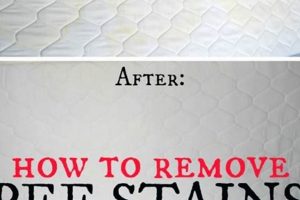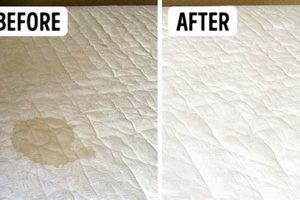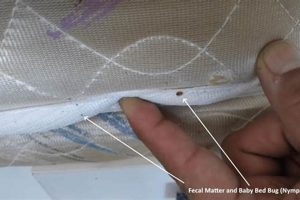The disposal of a used sleeping surface without incurring any expenses involves several potential methods. This process often necessitates research and effort to identify viable, cost-free options.
Properly discarding these items prevents environmental damage from illegal dumping and promotes resource recovery through recycling initiatives. Historically, mattress disposal relied heavily on landfill usage, but increasing environmental awareness has fostered alternative practices.
The following sections detail various avenues for achieving zero-cost removal, encompassing charitable donations, municipal services, and online community resources, and responsible disposal processes.
Tips for Mattress Disposal Without Charge
Efficient and economical mattress disposal requires careful planning and knowledge of available resources. The following tips offer practical strategies for eliminating a used mattress without incurring disposal fees.
Tip 1: Utilize Municipal Services: Contact the local waste management authority to inquire about bulky waste collection programs. Many municipalities offer scheduled pick-ups for large items, including mattresses, often at no direct cost to residents.
Tip 2: Explore Charitable Donations: Check with local charities and non-profit organizations that accept furniture donations. Ensure the mattress meets their condition requirements, typically free from stains, tears, and infestations, before attempting a donation.
Tip 3: Research Recycling Centers: Investigate mattress recycling facilities in the area. Some centers accept mattresses for recycling, extracting valuable materials for reuse, and may offer drop-off services at no charge.
Tip 4: Leverage Online Marketplaces and Community Networks: Post the mattress on online marketplaces or community forums, offering it for free to individuals willing to transport it. Clearly state the condition and dimensions of the mattress in the listing.
Tip 5: Deconstruct for Parts and Disposal: As a last resort, consider disassembling the mattress and disposing of the components separately. Steel springs can be recycled at metal recycling facilities, while fabric and foam may be discarded in regular trash or repurposed for other uses. Be cautious while disassembling, follow safety protocols, and wear safety equipment.
Tip 6: Freecycle Networks: Explore Freecycle or similar community exchange groups where people give away unwanted items for free. This can be a quick way to find someone willing to take the mattress off your hands.
Tip 7: Check Retailer Take-Back Programs: Inquire whether retailers offer mattress take-back programs when purchasing a new mattress. Some retailers may remove the old mattress for free or at a reduced cost as part of the purchase agreement.
By employing these strategies, individuals can effectively and responsibly remove a mattress, avoiding unnecessary disposal expenses and contributing to environmental sustainability.
The subsequent sections will delve into the environmental impact of improper disposal and the long-term benefits of choosing cost-effective and responsible alternatives.
1. Local regulations compliance
Adherence to local ordinances is paramount when seeking mattress disposal without charge. Disregarding these regulations may result in fines or other legal repercussions, thereby undermining the intent of securing a free disposal method.
- Prohibited Disposal Methods
Municipalities often prohibit specific mattress disposal practices, such as illegal dumping on public or private property. Violators face penalties ranging from fines to mandated community service, rendering the initial objective of cost-free disposal irrelevant due to the imposition of subsequent charges.
- Designated Collection Events
Many jurisdictions organize periodic bulky waste collection events where residents can discard large items, including mattresses, at designated locations or through curbside pick-up. Non-compliance with specified event schedules and location requirements can result in rejection of the mattress, forcing residents to seek alternative, potentially costly, disposal options.
- Permitted Recycling Facilities
Local regulations may mandate mattress recycling whenever feasible. Identifying and utilizing permitted recycling facilities becomes essential to avoid contravening these ordinances. Failure to recycle when required can lead to penalties or denial of waste removal services.
- Specific Preparation Requirements
Some localities stipulate particular preparation steps for mattress disposal, such as wrapping the mattress in plastic to prevent the spread of bedbugs or other pests. Ignoring these requirements can result in refusal of collection or acceptance at disposal facilities.
Therefore, prior to undertaking any mattress disposal method, consulting local waste management guidelines is crucial. Such due diligence ensures compliance with all applicable regulations, facilitating a legal and truly cost-free disposal process.
2. Donation eligibility criteria
The feasibility of mattress donation as a free disposal method hinges critically on meeting specific eligibility standards set by charitable organizations. These criteria are designed to ensure the usability and safety of donated items, directly impacting the viability of this disposal route.
- Absence of Stains and Damage
Charities typically require mattresses to be free from significant stains, tears, or other forms of damage. Stained or damaged mattresses are generally deemed unsanitary or unsuitable for reuse, precluding their acceptance and necessitating alternative disposal methods.
- Lack of Infestation
Mattresses must be free of bedbugs, dust mites, or other infestations. Infested mattresses pose a health risk and can transmit pests to other donated items or the charity’s facilities. Consequently, any evidence of infestation will disqualify a mattress from donation.
- Structural Integrity
The structural integrity of the mattress must be intact. Mattresses with sagging, broken springs, or other structural deficiencies are generally rejected, as they fail to provide adequate support and comfort for intended users.
- Compliance with Regulations
Some jurisdictions impose regulations on the types of mattresses that can be donated, such as restrictions on donating certain older models or requirements for specific labeling. Compliance with these regulations is essential for a successful donation.
The stringency of donation eligibility criteria underscores the importance of assessing a mattress’s condition prior to considering donation as a disposal strategy. Failure to meet these standards necessitates exploring alternative, potentially more costly, options to achieve responsible disposal.
3. Recycling center availability
The accessibility of mattress recycling centers directly influences the feasibility of discarding a mattress without incurring expenses. The presence or absence of these facilities shapes the landscape of disposal options and dictates the methods available to individuals seeking cost-free solutions.
- Geographic Proximity and Transportation Logistics
The distance to the nearest recycling center presents a primary consideration. If a facility is located remotely, the cost of transportation, whether through personal vehicle or hired service, may negate the potential savings from free recycling. In such instances, the actual cost of disposal increases, impacting the overall feasibility of this method.
- Acceptance Policies and Material Restrictions
Recycling centers often maintain specific acceptance policies regarding the types of mattresses they process. Some facilities may only accept mattresses in certain conditions, such as those free from severe stains or infestations. Others might restrict the intake of mattresses containing specific materials. Understanding these restrictions is crucial to determining whether a mattress qualifies for free recycling.
- Drop-off Schedules and Operational Hours
Recycling centers operate within defined schedules and operational hours. These limitations can impact the convenience and accessibility of free disposal. Limited hours may necessitate storing the mattress for an extended period, potentially creating logistical challenges or inconveniences.
- Potential Handling Fees and Service Charges
While some recycling centers offer free drop-off services, others may impose handling fees or service charges to offset processing costs. It is essential to verify the fee structure before transporting a mattress to the facility, as these charges can undermine the objective of achieving cost-free disposal.
The presence of accessible and accommodating recycling centers significantly enhances the viability of discarding a mattress without charge. However, various factors, including distance, acceptance policies, schedules, and potential fees, must be carefully evaluated to determine the true cost-effectiveness of this disposal method. The absence of convenient recycling options necessitates exploring alternative strategies to achieve the desired outcome of free mattress removal.
4. Community network effectiveness
The efficacy of community networks directly influences the ability to achieve mattress disposal without monetary cost. Platforms such as Freecycle, Craigslist’s “free” section, and local neighborhood groups facilitate the connection between individuals seeking to dispose of unwanted items and those willing to acquire them. The success of these networks in enabling no-cost mattress removal depends on several factors, including network size, member engagement, and the quality of item listings. A larger, more active network increases the likelihood of finding a recipient willing to take the mattress. Clear and accurate descriptions of the mattress’s condition are crucial to attract potential takers and avoid wasted effort. For instance, a local community Facebook group with hundreds of active members might quickly match a gently used mattress with a family in need, whereas a smaller, less engaged group might yield no results. Real-life instances abound where individuals have successfully utilized these networks, saving on disposal fees and promoting resource reuse.
The geographical scope of the network also plays a significant role. Hyperlocal networks, focusing on specific neighborhoods or towns, tend to be more effective due to reduced transportation distances for potential recipients. Moreover, the responsiveness of network participants is critical. A timely response to inquiries and a willingness to coordinate pickup logistics enhance the overall effectiveness of the network in facilitating free mattress disposal. For example, a community email listserv dedicated to sharing free items might prove invaluable, provided members actively monitor and respond to messages promptly. Furthermore, establishing clear guidelines within the network, such as specifying pickup requirements and acceptable mattress conditions, contributes to a smoother and more efficient disposal process.
In summary, the effectiveness of community networks is a pivotal element in achieving cost-free mattress disposal. The success hinges on network size, member engagement, accurate listings, geographical proximity, and responsive communication. While these networks offer a valuable resource, their reliability varies, and successful utilization requires proactive participation and clear communication to ensure a mutually beneficial outcome.
5. Disassembly safety protocols
The viability of mattress disassembly as a cost-free disposal method is contingent upon strict adherence to established safety protocols. The inherent risks associated with disassembling a mattress necessitate careful planning and execution to prevent injury and ensure a safe outcome.
- Protective Equipment Usage
Appropriate personal protective equipment (PPE) is critical. Safety glasses mitigate the risk of eye injury from stray staples or debris. Heavy-duty gloves protect hands from sharp edges and protruding springs. Wearing appropriate footwear, such as closed-toe shoes or work boots, safeguards feet from puncture wounds and impact injuries. Neglecting these precautions increases the likelihood of accidents and injuries, rendering the attempted cost-free disposal potentially expensive due to medical expenses.
- Tool Selection and Handling
Selecting the correct tools for mattress disassembly is essential. A sturdy staple remover expedites the process of removing fabric and padding without causing damage or injury. Wire cutters are necessary for severing springs and metal components. Employing these tools correctly and maintaining a firm grip minimizes the risk of slippage and accidental cuts. Improper tool handling amplifies the chance of injury, negating the economic benefits of DIY disassembly.
- Spring Compression and Release
Controlling the compression and release of mattress springs demands caution. Springs under tension can recoil with significant force, posing a serious safety hazard. Using appropriate leverage and restraint techniques to manage spring tension is paramount. Uncontrolled spring release can result in lacerations, puncture wounds, and other severe injuries, undermining the aim of a cost-free disposal method due to potential medical costs.
- Material Handling and Disposal
Safe handling and disposal of disassembled mattress components is vital. Sharp metal edges and protruding staples present cutting and puncture hazards. Proper disposal of foam and fabric remnants is necessary to prevent environmental contamination. Following local waste management guidelines ensures responsible disposal and avoids potential fines or penalties. Neglecting responsible material handling and disposal can lead to environmental damage and legal ramifications, negating the initial objective of achieving a cost-free outcome.
The implementation of rigorous disassembly safety protocols is indispensable when attempting to eliminate a mattress without charge through DIY methods. Prioritizing safety not only prevents injuries but also ensures compliance with environmental regulations and avoids potential financial burdens arising from accidents or improper disposal practices. The seemingly cost-free approach becomes expensive and risky if safety is compromised.
6. Retailer take-back options
Retailer take-back programs represent a potential avenue for mattress disposal without charge, contingent upon specific retailer policies and purchase conditions. These programs, when available, offer consumers a convenient means of eliminating an old mattress upon purchasing a new one, aligning with the objective of cost-free disposal.
- Inclusion in Purchase Agreements
Some retailers incorporate mattress removal as a standard part of their purchase agreements, particularly for premium mattress brands or high-end models. This service is often bundled into the overall price, effectively masking the disposal fee. However, consumers benefit from the convenience of having the old mattress removed at no additional, explicitly stated cost. The programs integration into the purchase often hinges on the price tier of the new mattress. For example, a high-end purchase might automatically include removal, whereas a budget-friendly purchase may require a separate disposal fee.
- Optional Add-on Services
Other retailers offer mattress removal as an optional add-on service at the point of sale. While not strictly free, the cost of this service may be significantly lower than alternative disposal methods, such as hiring a junk removal company or paying landfill fees. Consumers can weigh the cost of the add-on service against other options to determine the most economical approach. A consumer might find that adding mattress removal to their purchase is more cost-effective than renting a truck and personally transporting the mattress to a disposal facility.
- Recycling Partnerships and Initiatives
Certain retailers partner with mattress recycling organizations, facilitating the responsible disposal of collected mattresses. These partnerships often allow retailers to offer free or discounted take-back services, as the mattresses are diverted from landfills and processed for material recovery. This aligns with sustainability goals while providing a cost-effective disposal solution for consumers. Retailers might advertise their eco-friendly practices to incentivize customers to choose their take-back program over other disposal methods.
- Geographic Limitations and Availability
The availability of retailer take-back programs is often subject to geographic limitations. Retailers may only offer these services in specific regions or metropolitan areas due to logistical constraints or variations in local regulations. Consumers should verify the availability of take-back options in their area before making a purchase, as geographic limitations can preclude access to this potentially cost-free disposal method. For instance, a national retailer may offer mattress removal in urban centers but not in more remote or rural areas.
Retailer take-back programs offer a potentially viable pathway for mattress disposal without charge, contingent upon purchase agreements, optional add-on services, recycling partnerships, and geographic availability. Consumers should carefully investigate these factors to determine whether this option aligns with their specific circumstances and facilitates a cost-effective and responsible disposal outcome. Moreover, exploring the nuances of individual retailers’ policies is critical to uncovering the most advantageous disposal options.
7. Curbside collection schedules
Curbside collection schedules offered by municipal waste management services present a direct pathway for discarding a mattress without incurring individual disposal fees. These schedules, typically published annually or seasonally, delineate specific dates and guidelines for the collection of bulky waste items, including mattresses. Adherence to these schedules is critical; non-compliance often results in the rejection of the mattress, necessitating alternative, potentially costly, disposal methods. For example, a city might designate the third Wednesday of each month for bulky waste pickup, requiring residents to place their mattress curbside no earlier than the evening before to avoid fines or service refusal.
The practical significance of understanding and utilizing curbside collection schedules stems from the cost savings and environmental responsibility they afford. Properly utilizing these services diverts mattresses from landfills, potentially leading to material recovery through municipal recycling programs. Moreover, avoiding illegal dumping, which carries substantial fines and environmental consequences, is a direct benefit of adhering to published collection schedules. Consider a homeowner who successfully discards their mattress during the designated collection week, thereby avoiding a $50 to $100 disposal fee charged by private waste haulers. This illustrates the tangible economic benefit of utilizing municipal services.
Challenges may arise in interpreting and applying curbside collection schedules. Municipal websites and publications may contain complex or ambiguous information, requiring residents to contact waste management authorities directly for clarification. Additionally, some municipalities impose restrictions on the number of bulky items collected per household or require specific preparation steps, such as wrapping the mattress in plastic to prevent the spread of bedbugs. Overcoming these challenges requires proactive engagement with local waste management services and meticulous adherence to specified guidelines, ultimately enabling a cost-free and environmentally sound mattress disposal solution.
Frequently Asked Questions
This section addresses common inquiries regarding mattress disposal without incurring expenses, offering concise and authoritative answers to facilitate informed decision-making.
Question 1: Are there legal repercussions for improper mattress disposal?
Yes, improper disposal, such as illegal dumping, may result in fines and legal penalties, varying based on local regulations.
Question 2: What mattress conditions disqualify it from charitable donation?
Stains, tears, infestations, and structural damage typically render a mattress ineligible for donation to charitable organizations.
Question 3: Do mattress recycling centers accept all mattress types and components?
No, acceptance policies vary. Certain centers may restrict intake based on mattress type, material composition, or overall condition.
Question 4: How reliable are online community networks for facilitating free mattress removal?
Reliability fluctuates. Success depends on network size, member engagement, accurate item descriptions, and the willingness of recipients to arrange transportation.
Question 5: What safety precautions are essential when disassembling a mattress for disposal?
Wearing protective equipment, employing appropriate tools, controlling spring tension, and adhering to responsible material handling practices are crucial for safety.
Question 6: Are retailer take-back programs consistently available across different geographic locations?
No, geographic limitations often apply. The availability of retailer take-back programs can vary based on region, logistical constraints, and local regulations.
Successful strategies involve careful assessment of factors such as regulatory compliance, mattress condition, recycling center accessibility, community network engagement, disassembly safety, and retailer program availability.
The subsequent sections will explore the environmental impact of mattress disposal and alternative strategies that align with sustainable practices.
Concluding Remarks
This exploration of how to get rid of a mattress for free has illuminated various avenues for achieving this objective. Municipal services, charitable donations, recycling centers, community networks, cautious disassembly, and retailer programs each present potential solutions, demanding careful evaluation of individual circumstances and local resources.
The decision-making process necessitates weighing regulatory compliance, logistical considerations, and safety protocols. While complete financial freedom from disposal costs remains contingent upon numerous factors, informed planning and diligent execution can significantly minimize expenses and promote responsible environmental stewardship. The commitment to responsible disposal, regardless of financial implications, reflects a broader societal obligation to environmental sustainability.







